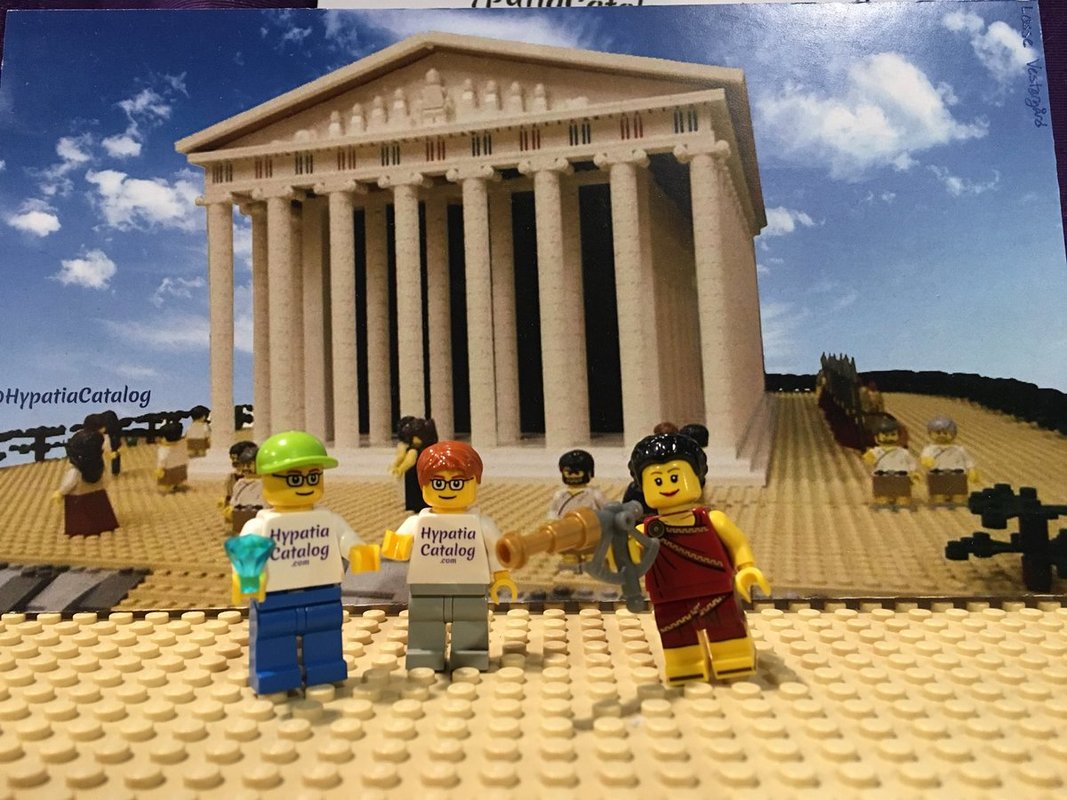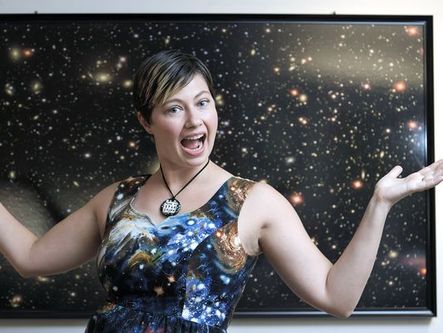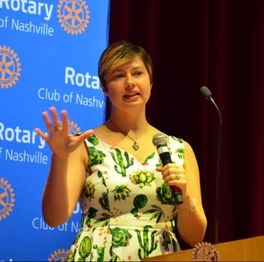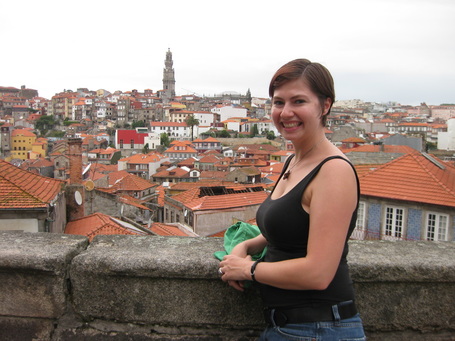|
|
For those fans of attending science talks in a pub or music venue, there is Astronomy on Tap! Here I am (at 44:30min) talking to the largest crowd (~700 people) in the history of AoT at the Republic NOLA. All of this took place during American Astronomical Society conference (Jan 2024). Things were loud, boisterous, and full of cursing and science -- we all had a fantastic time. Be sure to see if there is an AoT near you!
In advance of the Oct 14, 2023 annular eclipse sweeping through the southwest US, I gave a live radio interview with WWL's First News with Tommy Tucker in New Orleans. Check out the fun discussion here! (Image credit: Kevin Baird) The Origins Institute at McMaster University invited me to give a one hour public lecture on my research, the science questions I'm pursuing, and what I'm considering in the future. This should be accessible to everyone, so hopefully you'll get a good overview of what I work on. 😃
|
|
|
To talk a bit more about phosphorus -- why it's interesting for astrobiology but oh-so-hard to measure, I was interviewed by the lovely people at Cosmic Companion. If you listen closely, you'll catch a couple of super nerdy sci-fi references!
|
|
I have been working with oceanographer and overall amazing person Hilairy Hartnett on connecting stars, planets, and life. Basically, we've been trying to understand what the elements that are necessary for life, i.e. "bio-essential" elements like C, N, O, P, and S, look like in stars. However, we've run into some complications along the way -- which I discuss in an interview with Space.com!
|
|
I wrote a(nother) article for The Conversation about why we typically only observe planets that are small and rocky, like the Earth, or large and gaseous, like Jupiter. In other words, I explain why it's hard to create a super-Earth exoplanet!
|
|
|
Video from PechaKucha San Antonio Vol. 35!
In 2010, I initiated an ambitious project (as part of my PhD) to aggregate various collected stellar abundance data into a single massive database. The Hypatia Catalog, as it would eventually be known, makes available all of this data for the benefit of students, scientists, and our collective effort to better understand the universe and habitable planets. |
|
Photo I was a speaker for PechaKucha San Antonio's 35th event at the Empire Theater. I went into the background of the Hypatia Catalog: how I built it as a graduate student new to the stellar abundance field and not-so-great at programming -- and how it almost didn't happen! Photo to the left is courtesy of Gary Sweeney -- local artist, friend, and wonderful emcee! |
|
I wrote a machine learning algorithm that is sort of similar to movie-streaming services, like Netflix. Except, instead of searching for movies you haven't watched (but would probably like) -- it tries to find stars likely to host giant planets based on the composition of the star. Stars and planets are made at the same time, so it's like looking for chemical signatures the planets leaves on the star. This is probably one of the coolest projects I've worked on...and other people thought so too! Below are links to articles written by me and various journalists. |
|
Article I wrote via The Conversation website.
Discussion and article by Lisa Grossman through Science News. Interview and article by Kimberly Cartier -- a staff writer at EOS. Similar articles were written or picked up by Popular Mechanics, Science Daily, Space Daily, Interesting Engineering, Science Node, Nakshatra blog, etc.. |
|
|
I'm not sure if this is quite "outreach" such that everyone will understand it, but I gave a keynote talk to a group of data scientists at AnacondaCon and had a really amazing time at the conference. Here is the talk, in it's entirety! Also, this is an amazing recap video they put together -- look for me in orange! 😃 |
|
The Science Bar team was at it again, but this time at Emerald City Comicon in Seattle! We did a live recording of the podcast with special guests Dr. Jim Davenport and Dr. Regina Barber Degraaff! We had a wonderful audience who rode that nerdy, somewhat tipsy rollercoaster of science news with us -- everything from lab grown meat to sexy planets to sea slugs (better yet, "slea slugs"). We'll post the new show as soon as we can!
|
|
|
I had an amazingly fun time as a special guest on Weekly Space Hangout -- talking with Fraser Cain, Dr. Kimberly Cartier, Paul Sutter, and Morgan Rehnberg about my research and recent science news. This was a live YouTube discussion with them and their crew, who chime in via chat and ask questions as we go -- which was a great way to interact with people in different ways! |
|
I spoke at San Antonio's Astronomy on Tap, held at the Blue Star Brewery, discussing "Stardust: From Stars to Planets to You!" We had a wonderful crowd -- over 100 people showed up to drink beer and listen to some nerdy talks. I highly recommend going to one of these events, if you have the chance, they are SO much fun. 😃
Thanks to Drs. Tracy Becker (organizer), Rob Ebert (other speaker), and Vincent Hue (organizer), shown below. |
|
|
My TEDxSanAntonio 2018 talk! Also, for those of you interested in getting some of the behind-the-scenes details, here is a blog I wrote discussing my experience and some things not shown in the video. Hah! |
|
|
So this isn't 100% science outreach, but it is a little. Mostly, it's just stupidly cool: I was a contestant on the NPR news quiz show "Wait Wait...Don't Tell Me!" Small spoiler -- I won! Click on the link to the left for my segment!. |
|
In preparation for my TEDxSanAntonio talk (video to come in the next few months), San Antonio Magazine did a profile on me and what I do! One of the great things about this article is that a large portion of it is a giant quote from me, in all of my eccentric glory. 😉
The image to the left is a screen capture from a video that I made and show during my TEDxSanAntonio talk. Here I show data from the Hypatia Catalog (blob in the middle) as well as APOGEE and GALAH data (fanning outward) to show the stars we've been able to measure for abundances in our corner of the galaxy (fake galaxy overlaid). I'm quoted in the American Museum of Natural History members magazine Rotunda about my experience. Software and data courtesy of NCSA / Digital Universe / American Museum of Natural History / Keith Hawkins / Natalie Hinkel. I wrote a short article for the Big Data in the Universe special issue (Sept 2018) of American Scientist Magazine. I talked generally about my research connecting elements in stars with exoplanetary compositions, called "Big Data on Exoplanet Composition." This issue also featured articles by a number of my friends and colleagues -- I highly recommend it! A description of my article and work was written up by the Southwest Research Institute, which was picked up by Phys.Org and the local NPR station (aka Texas Public Radio, or tpr.org). The Hypatia Catalog was featured in an article in EarthSky, explaining the data and why I named the database after Hypatia! |
|
It was my honor to receive the Postdoc of the Year award at Vanderbilt University (2018). To the left, Dean Mark Wallace is presenting me with the award. In addition, I was interviewed regarding my work and accomplishments over the past year.
I talked to ~800 middle and high school students as a speaker at IdeaFestival Bowling Green 2018 -- which is essentially like a TEDx event but for local teenagers. I discussed not only my research, but the lessons I learned along the way that kept me going. Afterwards, I met with many of the students and answered questions over Twitter. |

|

At the 231st American Astronomical Society (AAS) meeting during Jan 2018 in Washington, D.C., I ran an exhibitor booth to tell other astronomers all about the database! Attendees were given live demos of the website and had the chance to spin the raffle wheel to win....Hypatia minifigurines! To the left are a few examples!
(Photos courtesy of Kelley Hess) 
The AAS features people and booths from all over! Here is "Hypatia" (as part of a historical project) holding the minifigurine of Hypatia! Perfect. In the studios again! This time with Sharon Kay's show "What's the 411?" at WFSK Jazzy 88. Caleb and I talked with her and Dr. Kent Wallace, a physics professor at Fisk University, about the upcoming eclipse and whether all of the hype is really worth it (it is!). |
|
Caleb and I did an interview with the local Nashville radio station WXNA 101.5. We talked with host Ashley Crownover on her show "Nashville Haps." Take a listen here!
|
|
The Tennessean -- the principal daily newspaper in Nashville -- did a profile on me, what led me to become an astrophysicist, and how I try to define myself as more than the "stereotypical" scientist. The article appear both online and on page A4 of the Sunday, Aug 13, 2017 paper (including a feature on the front page)! The story was also picked up by USA Today.
Click here for a short video of me explaining why I'm excited about the eclipse. I did an incredibly fun interview with Doug Robinson as part of his podcast, "Life of Wonder." I expanded on some of the themes from my TEDx talk as well as some more of the science! Check out our conversation here or on iTunes. |
|
|
On March 17, 2017 I spoke at the TEDxNashville event on how "We're all stardust -- and why that should make you feel awesome." The event was held at the Tennessee Performing Arts Center and had roughly 2,000 people in attendance.
TEDxNashville blog post featuring me! One of the two talks that I gave at the Astrobiology Science Conference (AbSciCon) 2017, during a session that I chaired entitled "The Apple Doesn't Fall Far from the Tree: Insights into Planetary Habitability from Stellar Characterization." Here I am presenting a new CATalog of Stellar Unified Properties (or CATSUP) for FGK-Stars within 30pc. In Oct 2016, Dr. Caleb Wheeler and I went to visit a few second grade classes at South Point Elementary School in Washington, MO to talk to them about what it was to be a scientist. We also discussed how much scientists need to write in order to communicate their findings! The kids were super excited and asked a ton of great questions. I conducted research with a large, international team in order to determine which of the ~4000 exoplanets discovered by Kepler could potentially be habitable. Here is the ASU press release, which received wide circulation and was picked up by organizations such as Science Daily, the Daily Mail, and Space.com. (Aug 2016) |

My interview with LifeHacker's Career Spotlight: What I Do As An
Astrophysicist. (Dec 2015)
For more background on what inspired me to become
astrophysicist and life as a graduate student at Arizona State
University's School of Earth and Space Exploration (SESE), see
my conversation with the SESE Newsletter.
Astrophysicist. (Dec 2015)
For more background on what inspired me to become
astrophysicist and life as a graduate student at Arizona State
University's School of Earth and Space Exploration (SESE), see
my conversation with the SESE Newsletter.
|
|
Consultant for Seeker regarding the physics it would take to explode the Death Star in "Star Wars." (Dec 2015)
My interview with Kevin Conklin on the ASU Connections podcast (Dec 2015) Photo in Porto, Portugal during the Towards Other Earths II Conference. Wonderful article in Slate by my friend and collaborator, Dr. Mike Pagano, discussing weird planets and why he likes them. Plus, he mentions me! (June 2015) Seeker Interview with Trace Dominguez about my research. (Feb 2015) |

|
Interview with "She Does Science" -- a blog by women in science for girls who aspire to be in science.
(Sept 2015) |

|
Press releases from both Arizona State and San Francisco State University following the publication of my paper introducing the Hypatia Catalog.
(Aug 2014) |



























